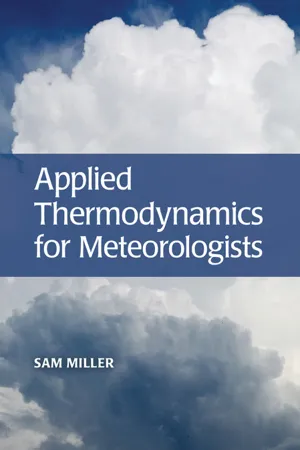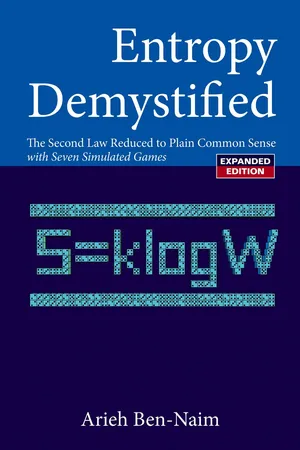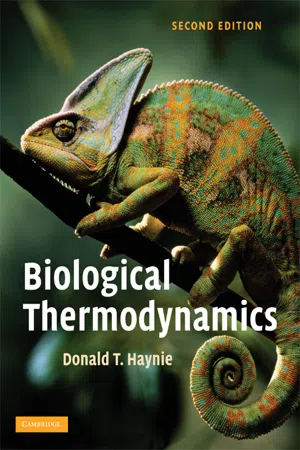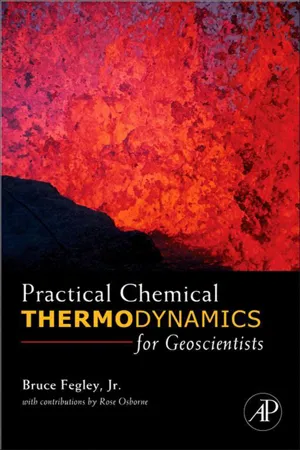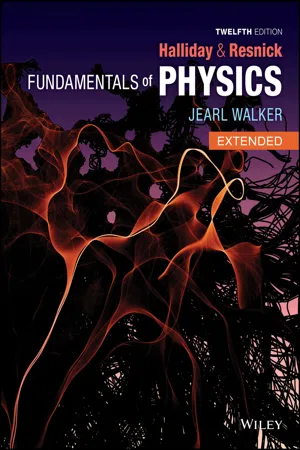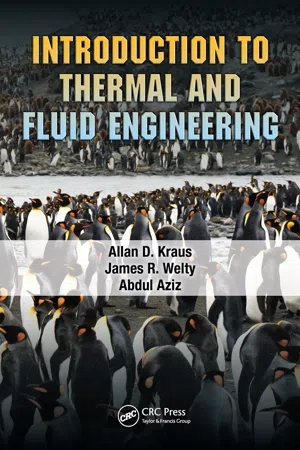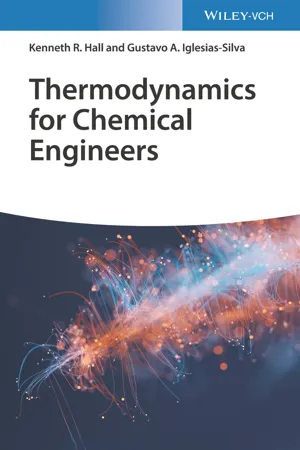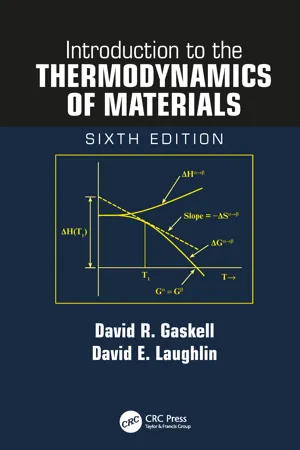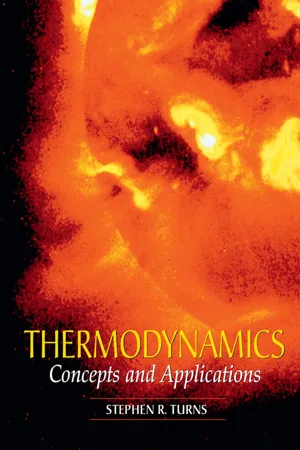Physics
Second Law and Engines
The Second Law of Thermodynamics states that in any energy conversion process, some energy is always lost as waste heat. This law places limits on the efficiency of heat engines, which are devices that convert thermal energy into mechanical work. It implies that no engine can be 100% efficient, as some energy will always be lost to the surroundings.
Written by Perlego with AI-assistance
Related key terms
1 of 5
12 Key excerpts on "Second Law and Engines"
- eBook - PDF
- Harold Morowitz(Author)
- 2012(Publication Date)
- Academic Press(Publisher)
4 The Second Law of Thermodynamics A . HEA T ENGINES AND REFRIGERA TORS There are few ideas in science that have been as difficult to comprehend as the second law of thermodynamics and the accompanying introduction of the entropy function. The concepts were first introduced in an engineering context; indeed Sadi Carnofs original 1824 monograph was entitled Re-flections on the Motive Power of Fire and on Machines Fitted to Develop that Power. From these considerations of steam engines a series of concepts has arisen which have profoundly influenced physics, chemistry, and a number of related sciences, including biology. The recently discovered relationships between entropy, work, and information and the profoundly informational character of biology have served to stress the deep connections between biology and thermal physics. In the following chapter we introduce this subject in a traditional way. In order to understand thermodynamics, it is necessary to comprehend how certain verbal statements about what cannot be done have been elaborated into some of our profoundest thoughts about the nature of the universe. Subsequently we will develop informational ideas which more closely relate entropic concepts to biology and allow us to sense the relation between the observer and the phenomena being observed. The classical approach to thermodynamics starts with a consideration of heat engines and refrigerators. In the final analysis the discipline is designed to deal with real engines and real refrigerators; however, in establishing the theory, certain limiting idealizations are used. If we are careful to define 33 34 4. The Second Law of Thermodynamics our concepts, this difference between real and idealized engines and refrig-erators will not be a cause of misunderstanding. The entities that we wish to deal with are then: 1. Heat Engine. A heat engine is a device which takes heat from a hot source and performs mechanical work (definition). - eBook - PDF
- George C. King(Author)
- 2023(Publication Date)
- Wiley(Publisher)
7 The second law of thermodynamics 7.1 Introduction Chapter 6 dealt with the first law of thermodynamics. That law deals with the energy balance in thermo- dynamic processes. It is essentially the conservation of energy when heat is taken into account. There are, however, processes that never happen even though they conserve energy. It is a familiar observation that heat flows from a hotter body to a colder body. The heat never flows from a colder to a hotter body, although this is not forbidden by the first law. The fact that it does not happen is a consequence of the second law of thermodynamics. So, while the first law deals with the energy balance in a process, the second law deter- mines in what direction a process will occur. Because of this, the second law is sometimes called the ‘arrow of time’. The subject of thermodynamics came to prominence in the eighteenth century for a very practical rea- son. The steam engine had been invented and was playing a central role in the industrial revolution. Steam engines were converting heat from the burning of coal into mechanical work to drive emerging industries. A very practical consideration was the maximum amount of work that a given steam engine could produce. Various designs of the steam engine were evolving with increasing efficiency, and it was important to know if there was a limit to the maximum possible efficiency. It was a young engineer Sadi Carnot who came up with the answer. He did not deal with the details of a particular steam engine but considered the problem in a much wider sense. Carnot obtained an expression for the maximum efficiency that a steam engine could have, or indeed any device that converts heat into work; so called heat engines. Carnot’s analysis of heat engines led eventually to the work of Rudolf Clausius who was a contemporary of Joule and Kelvin. Clausius developed the basic principles underlying the second law of thermodynamics and in 1865, he introduced the new concept of entropy. - eBook - PDF
- Sam Miller(Author)
- 2015(Publication Date)
- Cambridge University Press(Publisher)
113 6 The Second Law of Thermodynamics 6.1. Introduction The First Law was a statement about the conservation of energy, which in the twen-tieth century (thanks to the work of Einstein), was further generalized into a state-ment of conservation of energy and mass (which he showed were not independent of each other). Put simply, it now states that the sum totality of mass and energy in the universe is a constant . But there is another idea in thermodynamics, related but separate, that when translated into English, says you can’t get something for free – you always have to pay somehow . And payment is in the form of waste material of some sort. The Second Law of Thermodynamics , like the First Law, is often simply called the Second Law, because of the deceptively simple yet fundamental ideas that it captures. Every so often, someone claims to have built a machine (or claims to know how to build a machine) that runs on its own batteries so efficiently that it can recharge the batteries, and have enough energy left over to perform useful work, without consum-ing any fuel from an outside source. Once started, the machine perpetually recharges itself, and need never be refueled or even switched off. It will run forever. For this reason these mythical devices are known as perpetual motion machines . They do not exist and can never exist. A much more prosaic problem, examined and finally understood in the nineteenth century, was the inability to build steam engines that converted all the heat gener-ated in their boilers to mechanical work. In spite of the engineering genius applied, engines always dump some heat into the atmosphere. Their efficiency is always less than 100 percent, and in fact is much less than 100 percent. The Second Law explains both of these phenomena, and it also applies to the atmo-sphere. - eBook - ePub
Entropy Demystified: The Second Law Reduced To Plain Common Sense (Revised Edition)
The Second Law Reduced to Plain Common Sense
- Arieh Ben-Naim(Author)
- 2008(Publication Date)
- WSPC(Publisher)
caloric. Carnot was mainly interested in the limits on the efficiency of heat engines. He found out that the limiting efficiency depends only on the ratio of the temperatures between which the engine operates, and not on the substance (i.e., which gas or liquid) that is used in the engine. Later, it was shown that the efficiency of Carnot's idealized engine could not be surpassed by any other engine. This laid the cornerstone for the formulation of the Second Law and paved the way for the appearance of the new term “entropy.”It was William Thomson (1824–1907), later known as Lord Kelvin, who first formulated the Second Law of Thermodynamics. Basically, Kelvin's formulation states that there could be no engine, which when operating in cycles, the sole effect of which is pumping energy from one reservoir of heat and completely converting it into work.Although such an engine would not have contradicted the First Law of Thermodynamics (the law of conservation of the total energy), it did impose a limitation on the amount of work that can be done by operating an engine between two heat reservoirs at different temperatures.In simple terms, recognizing that heat is a form of energy, the Second Law of Thermodynamics is a statement that it is impossible to convert heat (thermal energy) completely into work (though the other way is possible, i.e., work can be converted completely into heat, for example, stirring of a fluid by a magnetic stirrer, or mechanically turning a wheel in a fluid). This impossibility is sometimes stated as “a perpetual motion of the second kind is impossible.” If such a “perpetual motion” was possible, one could use the huge reservoir of thermal energy of the oceans to propel a ship, leaving a tail of slightly cooler water behind it. Unfortunately, this is impossible.Another formulation of the Second Law of Thermodynamics was later given by Rudolf Clausius (1822–1888). Basically, Clausius’ formulation is what every one of us has observed; heat always flows from a body at a high temperature (hence is cooled) to a body at a lower temperature (which is heated up). We never observe the reverse of this process occurring spontaneously. Clausius’ formulation states that no process exists, such that its net effect is only the transfer of heat from a cold to a hot body. Of course we can achieve this direction of heat flow by doing work on the fluid (which is how refrigeration is achieved). What Clausius claimed was that the process of heat transferred from a hot to a cold body when brought in contact, which we observe to occur spontaneously, can never be observed in the reverse direction. This is shown schematically in Fig. (1.2) - eBook - PDF
- Donald T. Haynie(Author)
- 2008(Publication Date)
- Cambridge University Press(Publisher)
Some students find the Second Law hard to grasp. One reason is that there are numerous formulations of the Law, and it’s not always readily apparent that they are equivalent. It can be instructive to look at matter through the lenses of different observers, so to speak, as each sheds new light on the topic and helps to understand it in a different way. One of the earliest formulations of the Second Law from the historical point of view is of particular interest here because it helps to reveal the practical nature of the human activity out of which the science of thermodynamics developed. It is impos-sible for a system to turn a given amount of heat into an equivalent amount of work. In other words, if we put some quantity of heat q into the system, whatever work w is done by the system will be such that w < q . This comes to us from the work of the visionary French military engineer Nicolas Le ´ onard Sadi Carnot (1796–1832). Pub-lication of Carnot’s Re ´flexions sur la puissance motrice du feu et es machines propre a ` de ´velopper cette puissance 1 (at the age of 28!) outlined a theory of the steam engine and inaugurated the science of thermodynamics. We shall encounter M. Carnot again shortly, but in a different chamber of the mansion of biological thermodynamics. B. Entropy The foregoing discussion brings us to the thermodynamic state function S , entropy (Greek, en , in þ trope , transforming; also coined by Clausius). Being a state function, the entropy change for a process is independent of path, regardless of whether the change is 1 Report on the driving force of heat and the proper machines to develop this power . ENTROPY 61 reversible or irreversible. The entropy is an index of the tendency of a system to undergo spontaneous change; it is a measure of the state of differentiation or distribution of the energy of the system. The entropy is the key to understanding energy transformation. - eBook - PDF
- Alberto Patiño Douce(Author)
- 2011(Publication Date)
- Cambridge University Press(Publisher)
4 The Second Law of Thermodynamics and thermodynamic potentials The First Law of Thermodynamics, like all conservation laws, is expressed mathematically by an identity relationship. As such, it is incapable of predicting the direction in which a natural process will occur. For example, on the basis of energy conservation alone it is not possible to decide whether heat flows from a hot body to a colder one, or the other way around. We know that heat flows down a temperature gradient, but this does not follow from the First Law. Similarly, energy conservation cannot predict that ice will melt at 20 ◦ C, or that water will freeze at −20 ◦ C, and it cannot predict that a gas will expand to fill all of the volume available to it. Another law of nature is required to predict the direction of spontaneous changes. By “spontaneous” we mean a process that occurs in nature in the direction towards equilibrium and without outside intervention. For example, heat flow down a temperature gradient is a spontaneous process. It is possible to transfer heat from a cold body to a hotter one, but this requires “outside intervention” in the form of a heat pump, which uses mechanical energy to accomplish a process that is not “naturally spontaneous”. As soon as the expenditure of mechanical energy ceases the spontaneous process takes over and the cold body heats up at the expense of the hotter one. The law that we are searching for, which is the Second Law of Thermodynamics, cannot be expressed by a mathematical identity, because identities are unable to determine direction. Therefore, it cannot be a conservation law. Rather, the Second Law of Thermodynamics must be a law that states that some quantity changes when a spontaneous process takes place, or, equivalently that the total content of some quantity in the observable universe varies monotonically with time. - Bruce Fegley Jr., Bruce Fegley, Jr.(Authors)
- 2012(Publication Date)
- Academic Press(Publisher)
Chapter 6
The Second Law of Thermodynamics and Entropy
Die Entropie der Welt strebt einem Maximum zu . (The entropy of the universe increases to a maximum.)—Rudolf Clausius (1865)Es ist unmöglich, eine Maschine zu konstruieren, die fortdauernd die Wärme der Umgebung in äußere Arbeit verwandelt . (It is impossible to construct a machine that continuously converts the heat of its surroundings into external work.)—Walther Nernst (1924) The law that entropy always increases—the second law of thermodynamics—holds, I think, the supreme position among the laws of Nature. —Sir Arthur Eddington (1929)Chapters 3 through 5 described the first law of thermodynamics and several of its applications. We can summarize this discussion by stating that the first law expresses the equivalence of the various forms of energy in general and of thermal energy (heat) and mechanical energy (work) in particular. The first law and the equations derived from it are general in their application. (The relationships derived for an ideal gas can be modified for real gases, as we will discuss later.)In this chapter we introduce the second law of thermodynamics. The second law is fundamentally different from the first law because it predicts the direction of spontaneous change for all chemical and physical processes. It also quantifies the amount of waste heat that is produced when heat is transformed into electrical or mechanical work. The first law does not consider either of these two important questions. These predictions depend on entropy , which is a new state function that is defined by the second law.This chapter is divided into nine sections. Section I reviews key definitions that were introduced earlier and are important for this chapter’s discussion. In particular, we review the definitions of reversible and irreversible processes. In Section II we discuss the historical development of the second law, which took 30 years. We give several verbal statements of the second law in Section III . These statements are easy to understand and convey the meaning of the second law. Section IV describes the Carnot cycle, which is a reversible thermodynamic cycle of an ideal machine that can be used as a heat engine (i.e., for converting heat into work) or as a heat pump (i.e., for cooling and refrigeration). The Carnot cycle is one of the most important concepts in thermodynamics and is the foundation of the second law. We use the Carnot cycle to calculate the maximum possible efficiency of any real heat engine and to show it is impossible to reach absolute zero. In Section V we use the Carnot cycle to define the thermodynamic (or absolute) temperature scale. We define entropy, discuss entropy changes for a system and its surroundings during reversible and irreversible (or spontaneous) processes, and give a mathematical statement of the second law in Section VI . In Section VII we discuss some applications of the second law. We first derive the combined first and second law, also known as the fundamental equation . Then we use the fundamental equation to calculate entropy changes for chemical and physical processes. We also describe entropy calculations for solids, liquids, and gases. We close Section VII with a description of entropy estimation methods for minerals. We introduce two new state functions, the Gibbs and Helmholtz free energies, in Section VIII , and use them to quantify the maximum work and net work that are obtained when heat is transformed into work. We then use the Gibbs free energy to calculate entropies for aqueous ions. Section IX- eBook - PDF
- David Halliday, Robert Resnick, Jearl Walker(Authors)
- 2021(Publication Date)
- Wiley(Publisher)
When an ideal gas changes reversibly from an initial state with temperature T i and volume V i to a final state with tempera- ture T f and volume V f , the change ΔS in the entropy of the gas is ΔS = S f − S i = nR ln V f ___ V i + nC V ln T f ___ T i . (20.1.4) The Second Law of Thermodynamics This law, which is an extension of the entropy postulate, states: If a process occurs in a closed system, the entropy of the system increases for irreversible processes and remains constant for reversible pro- cesses. It never decreases. In equation form, ΔS ≥ 0. (20.1.5) Engines An engine is a device that, operating in a cycle, extracts energy as heat |Q H | from a high-temperature reservoir and Additional examples, video, and practice available at WileyPLUS 634 CHAPTER 20 ENTROPY AND THE SECOND LAW OF THERMODYNAMICS does a certain amount of work |W|. The efficiency ε of any engine is defined as ε = energy we get _____________________ energy we pay for = |W| ______ | Q H | . (20.2.4) In an ideal engine, all processes are reversible and no waste- ful energy transfers occur due to, say, friction and turbulence. A Carnot engine is an ideal engine that follows the cycle of Fig. 20.2.2. Its efficiency is ɛ C = 1 − | Q L | ______ | Q H | = 1 − T L ____ T H , (20.2.5, 20.2.6) in which T H and T L are the temperatures of the high- and low- temperature reservoirs, respectively. Real engines always have an efficiency lower than that given by Eq. 20.2.6. Ideal engines that are not Carnot engines also have lower efficiencies. A perfect engine is an imaginary engine in which energy extracted as heat from the high-temperature reservoir is converted completely to work. Such an engine would violate the second law of thermodynamics, which can be restated as follows: No series of processes is possible whose sole result is the absorption of energy as heat from a thermal reservoir and the complete conversion of this energy to work. - Allan D. Kraus, James R. Welty, Abdul Aziz(Authors)
- 2011(Publication Date)
- CRC Press(Publisher)
6 The Second Law of Thermodynamics Chapter Objectives • To consider the idea of quality of energy. • To introduce the two statements of the second law of thermodynamics (the Kelvin-Planck statement and the Clausius statement) and to establish their equivalence. • To define what is meant by a reversible process and identify the causes of irre-versibility. • To describe the Carnot cycle and its use as a heat engine, a refrigerator, and a heat pump. • To discuss the Carnot cycle with external irreversibilities. • To develop the Kelvin and Rankine absolute temperature scales. 6.1 Introduction In Chapter 3, heat and work were identified as two forms of energy that are of primary interest in the study of thermodynamics and it was shown that the first law of thermody-namics relates the heat and work interactions at the boundary of a system to the change of energy within the system. The first law views heat and work as quantitatively equivalent to each other but places no restrictions on the conversion of heat into work or work into heat. In other words, the first law places no constraints on the direction of conversion. In practice, however, there is a preferred direction in which processes occur. For example, a sugar cube dissolves readily in a cup of coffee but the reverse, if it happens at all, would be considered a miracle. Similarly, objects fall off a table quite readily but do not rise up against gravity on their own. Heat flows from a higher temperature to a lower temperature on its own but the reverse process requires an expenditure of work. Gases expand, liquids mix, and fuels burn quite readily but a reversal of these processes is difficult to comprehend. Indeed, conversion of work into heat (friction) is commonplace but the conversion of heat into work is not so readily accomplished. The preferential direction for the occurrences of a process is intimately linked to the idea of the quality of energy .- eBook - ePub
- Kenneth Richard Hall, Gustavo Arturo Iglesias-Silva(Authors)
- 2022(Publication Date)
- Wiley-VCH(Publisher)
4 Second Law of Thermodynamics4.1 Introduction
We have learned that energy is a conserved variable and that transformations of energy follow the first law of thermodynamics. The second law, like the first law, is a part of normal human experience (except it is easier to observe its effects directly that those of the first law). Using the second law, we can determine the unique direction in which a spontaneous process proceeds, and how this direction relates to equilibrium (because spontaneous processes always proceed in the direction of equilibrium). For example, a stone can fall until it hits the ground, a perfume (concentrated solution) can disperse into the air (dilute solution) until it reaches a certain concentration, when two objects are in close contact excluding any interaction between them and their surroundings, the cold one always becomes hotter and the hot one becomes cooler. In other words, we must conserve energy, but we cannot do it just anyway we wish!We know from experience that the above examples occur in a specified direction, but the second law tells us mathematically why they must proceed in those particular directions. Interestingly, we can apply the first law to a system moving in either direction, and formulate an expression for each path (the expression is the same but with opposite signs), but the first law cannot determine the correct direction. In general, natural processes (removed from external forces) proceed toward a state of macroscopic rest with uniform distributions of temperature and concentration. In other words, natural processes proceed only in one direction, and they cannot return spontaneously to their original states without assistance from external forces.How can we relate the second law to our everyday experiences? We know that it can tell us if a process can proceed in certain directions, but we also can include the efficiency - No longer available |Learn more
- David R. Gaskell, David E. Laughlin(Authors)
- 2017(Publication Date)
- CRC Press(Publisher)
3 The Second Law of Thermodynamics 3.1INTRODUCTIONIn Chapter 2 , it was seen that when a system undergoes a change of state, the consequent change in the internal energy of the system is dependent only on the initial and final states and is equal to the algebraic sum of the thermal energy, q , and work, w , effects. Two questions now arise.1.What magnitudes may the q and w effects have?2.What criteria govern these magnitudes? Two extreme cases related to the first question can occur.•w = 0 and q = ∆U′•q = 0 and w = –∆U′But if q ≠ 0 and w ≠ 0, a third question arises.3.Is there a definite limit to the amount of work which the system can do during its change of state?The answers to these questions require an examination of the nature of the processes which affect q and w . This examination, which is made in this chapter, identifies two types of processes (reversible and irreversible processes) and introduces a state function called the entropy (S ).The concept of entropy will be introduced from two different starting points. In Sections 3.2 through 3.8, entropy will be seen as a quantification of the degree of irreversibility of a process. In Sections 3.10 through 3.14, it will be seen that, as a result of an examination of the properties of reversibly operated heat engines, there naturally develops a quantity which has all the properties of a thermodynamic state function. This state function is the entropy. These findings lead to a statement of the Second Law of Thermodynamics, which, together with the other laws of thermodynamics lay the foundation for the thermodynamic method of describing the behavior of matter to be discussed in the text.3.2SPONTANEOUS OR NATURAL PROCESSESA system left to itself will do one of two things: it may remain in the state in which it happens to be or it may change of its own accord to some other state. That is, if the system is initially in equilibrium with its surroundings, then, left to itself, it will remain in this equilibrium state. On the other hand, if the initial state is not the equilibrium state, the system will spontaneously* (i.e., without any external influence) move toward its equilibrium state. The equilibrium state is a state of rest (at least at the macroscopic level), and thus, once at equilibrium, a system will only move away from equilibrium if it is acted on by some external agency. Even then, the combined system, comprising the original system and the external agency, is simply moving toward the equilibrium state of the new combined system. A process which involves the spontaneous movement of a system from a nonequilibrium state to an equilibrium state is called a natural or spontaneous process. Since such a process cannot be reversed without the application of an external agency which leaves a permanent change in this agency, such a process is said to be irreversible . The terms natural , spontaneous , and irreversible - eBook - PDF
Thermodynamics
Concepts and Applications
- Stephen R. Turns(Author)
- 2006(Publication Date)
- Cambridge University Press(Publisher)
6 Second Law of Thermodynamics and Some of its Consequences 373 Self Test 6.5 ✓ Consider a piston–cylinder device containing 2 kg of saturated-liquid water at 300 K. Heat is added from a surrounding reservoir at 800 K until the water becomes saturated vapor. Determine the entropy change of the system, the entropy change of the surroundings, and the total entropy change. Assume internal reversibility. (Answer: S sys 16.25kJ/K, S surr 6.09kJ/K, S total 10.16kJ/K) For our entropy balance, this becomes (6.25b) Here we see that entropy enters (or leaves) the control volume by a heat interaction, the first term in Eq. 6.25b, or is carried in or out by the flow. The term represents the rate of entropy production within the control volume by irreversibilities. A common source of in real systems is fluid friction, either at the walls of a device or within the moving fluid itself. The right-hand term is the rate at which the entropy within the control volume increases. For steady state, this term is zero. The thermodynamic properties appearing in this entropy balance are the specific entropies s in and s out , the total entropy within the control volume, S cv , and the temperature T; and again are process-dependent quantities and are not thermodynamic properties. 6.6d Criterion for Spontaneous Change We now explore how the entropy-based second-law statements (Table 6.4) relate to the spontaneity of any real process. To begin, we define spontaneity or a spontaneous process as follows: A process is spontaneous if, in the absence of any interactions with the surroundings (i.e., heat or work), a system undergoes a change in state. What is meant by a spontaneous process can be made clear by considering the simple examples shown in Fig. 6.19: the mixing of two dissimilar gases, the free expansion of a gas into an evacuated space, and the transfer of heat from a hot body to a cold body.
Index pages curate the most relevant extracts from our library of academic textbooks. They’ve been created using an in-house natural language model (NLM), each adding context and meaning to key research topics.


